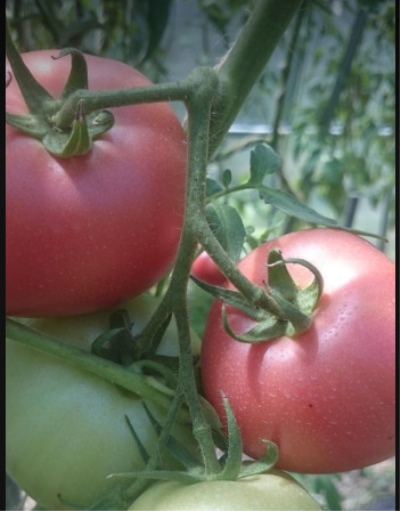
- Authors: Khovrin A. N., Tereshonkova T. A., Klimenko N. N., Kostenko A. N. (FSBSI "Federal Scientific Center of Vegetable Growing", LLC "Agrofirma Poisk")
- Year of approval: 2015
- Name synonyms: Star of the East F1
- Category: hybrid
- Growth type: indeterminate
- Appointment: fresh consumption, for pickling and preserving, for juice, for ketchup and tomato paste
- Ripening period: early
- Ripening time, days: 90-95
- Growing conditions: for film greenhouses
- Marketability: high
Any gardener seeks to get a rich harvest on his site. However, this does not always work out. The reason often lies in the wrong variety for cultivation in a particular region. The Star of the East tomato deserves special attention.
The hybrid was bred by domestic breeders in 2015 and every year it is gaining more and more popularity due to its excellent taste and due to its ease of growing, unpretentious care, productivity, resistance to many diseases.
Description of the variety
The Star of the East belongs to indeterminate hybrid varieties. In the process of development, the crown must be formed in 2-3 shoots. The bushes are tall - the height is 170-200 cm, they must be tied up. Leaves of medium length, green. 5-7 fruits are formed on one hand.
The tomato got its name from the characteristic arrangement of the chambers inside the tomato - in the form of an asterisk.
Basically, the variety is grown in film greenhouses, but it is also possible in the open field. Growing conditions depend on the climatic characteristics of the region. Culture is very resistant to harsh external factors. Calmly tolerates light frosts and prolonged drought.
The main qualities of the fruit
Tomatoes are large, with a pink color, the weight of one can reach 270-300 g. The shape of the fruit is round, even. About 5-6 tomatoes are formed on one cluster. The ripe crop is most often harvested with bristle branches.
The variety lies perfectly, without losing its presentation for a long time. It tolerates long-term transportation well. Marketability is high, the yield of vegetables is 80-90%.
Taste characteristics
Tomato Star of the East has an amazing delicious taste. It is pleasant, harmoniously combining sweetness and light sourness. Fleshy, dense and juicy pulp makes it possible to use the fruits both fresh and processed.
They make juices, sauces, pastes, the size allows them to be preserved as a whole, the skin is dense and does not burst. Their taste is best revealed when consumed freshly cut.
Ripening and fruiting
Differs in early ripening, which occurs 90-95 days after germination. Harvested in July and August.
Yield
The hybrid is high-yielding, stable. Competent care allows you to collect at least 15.6 kg from one square meter. With regular fertilizing, the amount of the crop increases to 20-22 kg. You can collect 5-6 kg from one bush.
The timing of planting seedlings and planting in the ground
Seeds begin to sow at the beginning of March, the soil should be moisture-permeable and fertile, to which peat, sand and compost are also added. Before starting planting, the seeds should be disinfected in a weak solution of potassium permanganate.
For germination of seedlings, special boxes or a greenhouse are used. Furrows are made in the soil 1.5 cm deep, sprinkled with earth and lightly tamped. The container is placed in a heated room. For seedlings to begin to appear, a temperature of 22-24 degrees is required. After the germination of the culture, they begin to harden it.
To get healthy and strong tomato seedlings Star of the East, it is watered with warm water, additionally illuminated with phytolamps and mineral and organic fertilizers must be added.
Tomatoes begin to dive when there are 3 real leaves - a distinctive feature of the hybrid. The seedlings are ready for planting in a permanent place in the greenhouse at the age of 50-55 days from the moment the first shoots appear - in mid-April. The plant is planted in open ground at the end of May.
When planting seedlings, it is impossible to deepen the seedlings, only the roots are added in. In conclusion, the bushes must be tied to a support and watered abundantly with warm water.

Growing tomato seedlings is an extremely important process, because it largely depends on whether the gardener will be able to harvest at all. All aspects must be taken into account, from seedbed preparation to planting in the ground.
Landing scheme
The holes are made at a distance of 30-40 cm from each other, between rows 70 cm. No more than 4 seedlings can be planted on one square meter.

Growing and care
The culture is not particularly demanding to care for. Competent cultivation consists in timely watering, fertilizing and loosening the earth. However, to get a good harvest, the Star of the East must be planted on nutrient-rich soil. You should also constantly apply mineral and organic fertilizers.
The variety is stress-resistant, therefore, after planting the seedlings in a permanent place, the tomato does not need to be given time to adapt. Saplings take root rather quickly. Irrigation is carried out several times a week. If the weather is hot and dry, increase watering. For less moisture loss, mulching is carried out. It is necessary to loosen the soil constantly - this procedure enriches the earth with oxygen.
The introduction of organic and mineral fertilizers is an important component of the good development of a tomato. Substances are introduced several times a month. This is especially true for nitrogen, potassium and phosphorus subcrust. Nitrogen allows you to build up green mass and develop the root system, and potassium affects the taste characteristics of tomatoes.




A plant needs different micronutrients at each stage of growth. All fertilizers can be divided into two groups: mineral and organic. Folk remedies are often used: iodine, yeast, bird droppings, eggshells.
It is important to observe the rate and period of feeding. This also applies to folk remedies and organic fertilizers.



























































































